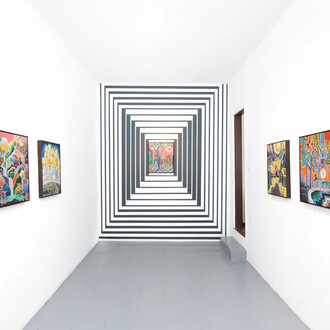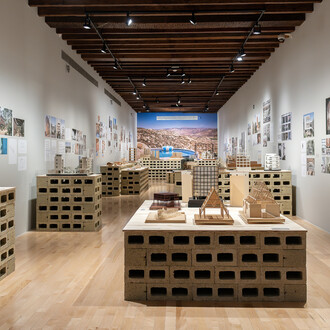Yoshua Okon: Colateral examines the video and multimedia work of Yoshua Okón, emphasizing how he has opened up various engagements with the social and political organization of groups active in a wide range of range of locations in North and South America, Europe and the Middle East. If Okón’s earlier work emphasized certain stagings of the self, often spawned by social dysfunction and personality disorders, the projects brought together in the current exhibition open a key front onto international relations. Okón’s video installations, sculptures and photographs are organized around a number of shared predicates according to which one group (denominated by nationality, ethnicity, or class) puts itself or its imagination of another group into representation, whether the collectives and subjects in question are perceived as “alien” or “friendly,” or submitted to disparagement or emulation. The exhibition showcases Okón’s signature politics of infiltration in which disparate social formations and coteries—including “border protectors,” suburban real estate agents, or small town boosters—act out and reinvent their own routines, lacing them with fantasies and speculative delusion. Okón creates an almost uncanny space in which these actions may be satirical or parodic, but are also transporting and often unpredictably—and oddly, even “incorrectly”—hilarious.
Rather than arranging the exhibition in a chronological or thematic sequence, it unfolds as a spiral that moves from Mexico City where Okón was born and has worked for the majority of his career (Bocanegra, 2007; Chocorrol, 1997), to a pair of engagements with the U.S.-Mexican border (Canned Laughter, 2009, and Oracle, 2015), and thence to Maine, the continental U.S. state furthest from DF, where Indian Project and Walmart Shoppers were made in 2015. From here Okón takes us to Guatemala via suburban Los Angeles (Octopus, 2011); south to Santiago de Chile (Chille, 2009); and finally to Herzliya in Israel where Gaza Stripper was performed and then re-presented as an installation in 2006.
Each project turns on an encounter in which cultural or racial others are subject to a kind of doubled representation: they are staged by the framing agency of the artist, but also, in many cases, by local amateur protagonists themselves. Each place is thus a proving ground for historical, racial or territorial projection fortified by fantasies of power, superiority or subjection. A street and apartment in a middle-class district of Mexico City are made over as a Nazi marching ground and meeting-room; the elderly officers of the Skowhegan Chamber of Commerce interpret a Native American dance while seated behind desks at a local TV station; workers in Santiago form a funeral cortege for the Chilean dictator, General Augusto Pinochet.
The geographical spiral of locales established in Okón’s video installations is supplemented by figures of circulation and recycling and by a new public project that foregrounds the making and signification of national emblems and corporate logos that has long interested Okón. The Plexiglas pipes of HCl (2004) carry vomit from a bulimia clinic through and around the exhibition; while Toilet (2016) delivers false glamor, demythologization, and a dose of flatulent bathos to the daily evacuations of the body. The circuits and symmetries represented by these works, animated by actions of pumping and siphoning, circling and flushing, reprise some of the key images in the artist’s videos: the manic roundabout motion of three white SUVs in Oracle; marching to-and-fro in Chille and Bocanegra; the production line dolly shot and life-sapping routines featured in Canned Laughter; geriatric jigs around a phantom totem pole in Indian Project; and war-mongering ricochets across a Los Angeles Home Depot parking lot in Octopus (2011).
For Flagging (2017), Okón produced twelve composite, crypto-national, flags based on the specific collisions of identity (corporate, social, national) played out in each of his video pieces. Flagging thus makes a pair with Presenta (1998) produced two decades earlier, a one-channel video-installation in which the artist collided a mish-mash of corporate and media logos from some of Mexico’s best-known institutions and corporations. Smaller, pennant-sized variants of flags punctuate the exhibition space where they offer a kind of fake symbolic arbitration of the related works in their zones of “governance.”
















